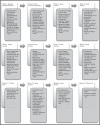Feasibility of Implementing the All Nations Breath of Life Culturally Tailored Smoking Cessation Program for American Indians in Multi-Tribal Urban Communities
- PMID: 28177511
- PMCID: PMC5892857
- DOI: 10.1093/ntr/ntx030
Feasibility of Implementing the All Nations Breath of Life Culturally Tailored Smoking Cessation Program for American Indians in Multi-Tribal Urban Communities
Abstract
Introduction: Prevalence of cigarette smoking is highest among American Indians, yet few culturally appropriate smoking cessation programs have yet been developed and tested for multi-tribal American Indian adult populations. This study examined implementation of the All Nations Breath of Life culturally tailored smoking cessation program in multi-tribal urban and suburban American Indian communities in seven locations across five states (N = 312).
Methods: This single-arm study used community-based participatory research to conduct a 12-week intervention whose primary purpose was to curb commercial tobacco use among American Indians. Participants were followed through month 6 in person and month 12 via telephone. The primary outcome was continuous abstinence from recreational cigarette smoking at 6 months post-baseline, verified through voluntary provision of salivary cotinine levels.
Results: At program completion (12 weeks post-baseline), 53.3% of program completers remained abstinent; labeling those lost to follow-up as smokers resulted in a 41.4% quit rate. At 6 months post-baseline (primary endpoint), 31.1% of retained participants quit smoking (p < .0001 compared to the highest quit rates among multi-tribal populations reported in the literature, 7%); final quit rate was 22.1% labeling those lost to follow-up as smokers (p = .002). Retention rate at endpoint was 71.2%. 12-month follow-up was attempted with all participants and had a retention rate of 49.0%. Of those participants reached, 34.0% were smoke-free.
Conclusions: All Nations Breath of Life shows promise as a smoking cessation program for multi-tribal urban American Indian communities. It can be successfully implemented in a variety of urban settings.
Implications: This is the first large feasibility study of a culturally tailored smoking cessation program for American Indians with good cessation and retention rates in a multi-tribal urban American Indian population. It shows that All Nations Breath of Life can be implemented in multiple urban settings across five states. To our knowledge, this is the first program of its kind to be implemented across multiple heterogeneous urban locations and to include salivary cotinine testing for verification of self-report data across these locations.
Figures
Similar articles
-
All Nations Breath of Life: A Randomized Trial of Smoking Cessation for American Indians.Am J Prev Med. 2016 Nov;51(5):743-751. doi: 10.1016/j.amepre.2016.05.021. Epub 2016 Jul 18. Am J Prev Med. 2016. PMID: 27436332 Free PMC article. Clinical Trial.
-
All Nations Breath of Life: using community-based participatory research to address health disparities in cigarette smoking among American Indians.Ethn Dis. 2010 Autumn;20(4):334-8. Ethn Dis. 2010. PMID: 21305818 Free PMC article.
-
Recruitment and Baseline Characteristics of American Indian Tribal College Students Participating in a Tribal College Tobacco and Behavioral Survey.Nicotine Tob Res. 2016 Jun;18(6):1488-93. doi: 10.1093/ntr/ntv226. Epub 2015 Oct 5. Nicotine Tob Res. 2016. PMID: 26438647 Free PMC article.
-
Commercial Tobacco Cessation Interventions for American Indian and Alaska Native Persons Living in the United States: A Narrative Systematic Review of Effectiveness Using a Health Equity Lens.Am J Health Promot. 2025 Feb;39(2):330-347. doi: 10.1177/08901171241293419. Epub 2024 Oct 22. Am J Health Promot. 2025. PMID: 39438073 Free PMC article.
-
Helping Low Income Pregnant Women Quit Smoking: Improving the First Breath Program.WMJ. 2019 Oct;118(3):120-125. WMJ. 2019. PMID: 31682747 Review.
Cited by
-
Pilot Testing All Nations Snuff Out Smokeless (ANSOS): A Culturally Tailored Smokeless Tobacco Cessation Program for American Indians.J Health Care Poor Underserved. 2021;32(4):2154-2166. doi: 10.1353/hpu.2021.0188. J Health Care Poor Underserved. 2021. PMID: 34803065 Free PMC article.
-
Development of a Culturally Appropriate Smokeless Tobacco Cessation Program for American Indians.J Health Dispar Res Pract. 2018 Spring;11(1):45-55. J Health Dispar Res Pract. 2018. PMID: 30906672 Free PMC article.
-
Editorial: Comparison of lung cancer and chronic obstructive pulmonary disease in smokers and never-smokers.Front Immunol. 2023 Feb 7;14:1143288. doi: 10.3389/fimmu.2023.1143288. eCollection 2023. Front Immunol. 2023. PMID: 36825024 Free PMC article. No abstract available.
-
Adaptation of a brief smoke-free homes intervention for American Indian and Alaska Native families.BMC Public Health. 2019 Jul 23;19(1):981. doi: 10.1186/s12889-019-7301-4. BMC Public Health. 2019. PMID: 31337379 Free PMC article.
-
Using Bayesian hierarchical models for controlled post hoc subgroup analysis of clinical trials: application to smoking cessation treatment in American Indians and Alaska Natives.J Biopharm Stat. 2024 Jul 3;34(4):513-525. doi: 10.1080/10543406.2023.2233598. Epub 2023 Jul 7. J Biopharm Stat. 2024. PMID: 37417836 Free PMC article.
References
-
- Martell BN, Garrett BE, Caraballo RS. Disparities in adult cigarette smoking - United States, 2002-2005 and 2010-2013. MMWR Morb Mortal Wkly Rep. 2016;65(30):753–758. - PubMed
-
- USDHHS. Tobacco Use among US Racial/Ethnic Minority Groups - African Americans, American Indians and Alaska Natives, Asian Americans and Pacific Islanders, and Hispanics: A Report of the Surgeon General. Atlanta, GA: U.S. Department of Health and Human Services, Centers for Disease Control and Prevention, National Center for Chronic Disease Prevention and Health Promotion, Office on Smoking and Health; 1998.
-
- Craig S. Tribal Tobacco Policy Workbook. Portland, OR: Northwest Portland Area Indian Health Board, Western Tobacco Prevention Project; 2005.
-
- Heron M. Deaths: leading causes for 2014. National Vital Statistics Reports. 2016;65(5):1–96. - PubMed
Publication types
MeSH terms
LinkOut - more resources
Full Text Sources
Other Literature Sources
Medical



